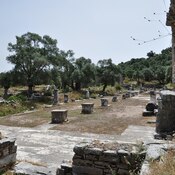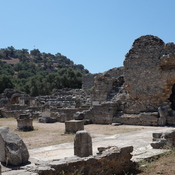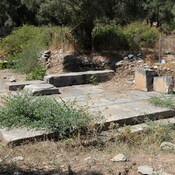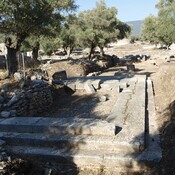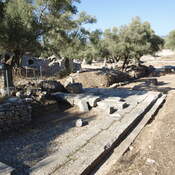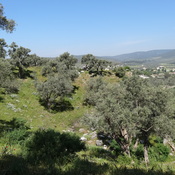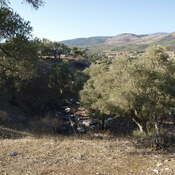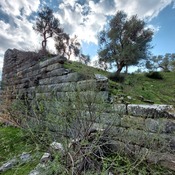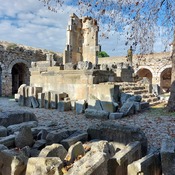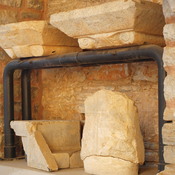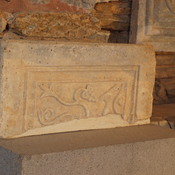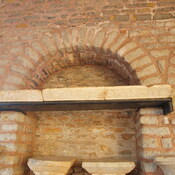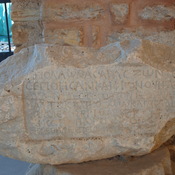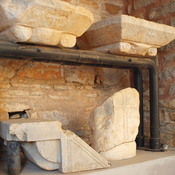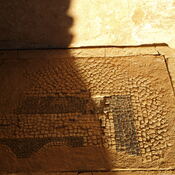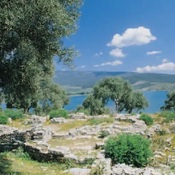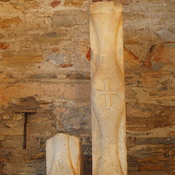The ancient settlement was originally founded on a rocky peninsula, or possibly a small separate island, in the 1shelter a bay called Sinus Iasicus - Gulf of Iasos. It had been occupied since the Late Neolithic period,and grew considerably in size during the Early Bronze Age. Iasos was colonized by Argives in the 9th or 8th century. According to Greek tradition they were founders of the city.
Near the eastern gate of the city the settlement dates to the Middle and Late Bronze Age was discoveres during the excavation. Yielded remains prove the relationship between Iasos and the Aegean Islands. These relationships interrupted the eruption of the Santorini volcano wchich can be observed as the ash layer in the Iasos agora. The geometric tombs dated back to 8th - 7th centuries BC were discovered under the agora on the northwest plain of the island. In the 5th century BC Iasos belonged to the Delian Leage, a military alliance against any enemies that might threaten Ionian Greeks. Unfortunately the city was plundered by the Spartan army and Tissaphernes a Persian Satrap of Lydia and Ionia.
Polybius:
The city of Iasus lies on the coast of Asia on the gulf situated between the Milesian Poseidon and Myndus, called by some the gulf of Iasus, but usually known as the gulf of Bargylia after the names of the cities at the head of it. It claims to have been originally a colony of Argos recolonized from Miletus, the son of Neleus the founder of Miletus having been invited there by the ancient inhabitants owing to the losses they had suffered in their war with the Carians.The town has a circumference of •ten stades. It is reported and believed that at Bargylia no snow nor rain ever falls on the statue of Artemis Kindyas, although it stands in the open air, and the same story is told of that of Artemis Astias at Iasus.
Tucydides:
Upon their arrival Tissaphernes came to them with his land forces and induced them to sail to Iasus, which was held by his enemy Amorges. Accordingly they suddenly attacked and took Iasus, whose inhabitants never imagined that the ships could be other than Athenian. The Syracusans distinguished themselves most in the action. Amorges, a bastard of Pissuthnes and a rebel from the king, was taken alive and handed over to Tissaphernes, to carry to the king, if he chose, according to his orders: Iasus was sacked by the army, who found a very great booty there, the place being wealthy from ancient date.
In the early second century BC the n the 2nd century BC that the city was badly damaged in the earthquake. In 168 BC Iasos came under the patronage of Rhodes. In 129 BC. together with the rest of the region it became part of the Roman province of Asia. During the Roman imperial period Iasos was a a prosperous city. It underwent phases of accentuated urban transformations in the 2nd century and 6th century, also in relation to the exploitation of the nearby quarries of Iassense marble (or "red cipollino"). It was a catholic titular see during Byzantine period.Literarure:
- George E. Bean, Turkey Beyond the Maeander. An Archaeological Guide, London Ernest Jersey 1971, pp. 69-81
- Ekrem Akurgal, Ancient Civilizations and Ruins of Turkey from Prehistoric Times Until the End of the Roman Empire,sec. ed. Istanbul 1970, p. 246-247
- Nicoletta Momigliano: Bronze Age Carian Iasos. Structures and finds from the area of the Roman Agora (ca. 3000-1500 BC), Archaeologica 166, Roma 2012
- http://www.associazioneiasosdicaria.org/joomla/index.php/missione/recente-bibliografia-su-iasos
- Marcello Spanu, The 2012 and 2013 Excavation and Research Campaigns at Iasos, in: 36. Kazı Sonuçları Toplantısı vol. 3, Ankara 2014, pp. 575-596 - https://www.academia.edu/13891359
- Thucydides, History of the Peloponnesian War, VIII, 28
- Polybius, XVI, 12, 4
- Jorrit M. Kelder, Iasos, Bronze Age and Iron Age in: The Encyclopedia of Ancient History 2016
- http://www.perseus.tufts.edu/hopper/artifact?name=Iasos&object=Site
- http://tayproject.org/TAYages.fm$Retrieve?CagNo=5270&html=ages_detail_e.html&layout=web
- Asuman Baldıran, Erdener Pehlivan, A Harbor City in Caria: Iasos in:ANODOS Studies of the Ancient World 15/2015 Baldıran Pehlivan, 2020, pp. 31-47
- Baldoni, D. , Franco, C. , Belli, P. , Berti, F,: Karia’da Bir Liman Kenti IASOS. İstanbul. Homer Kitabevi 2004>






